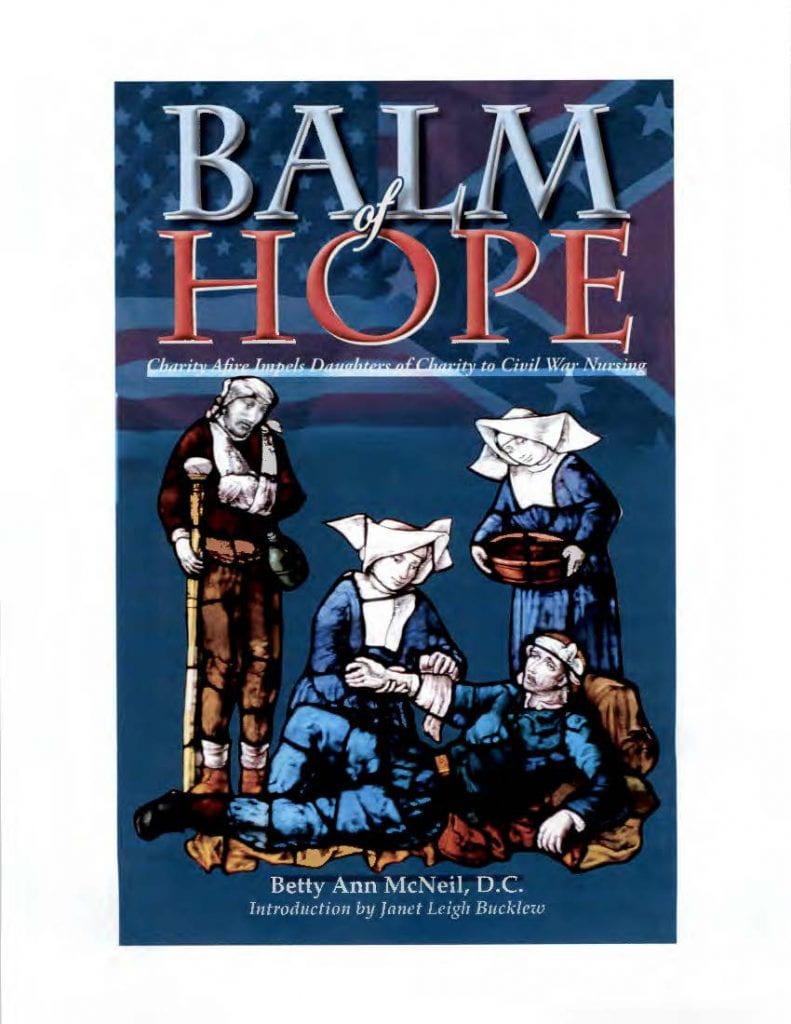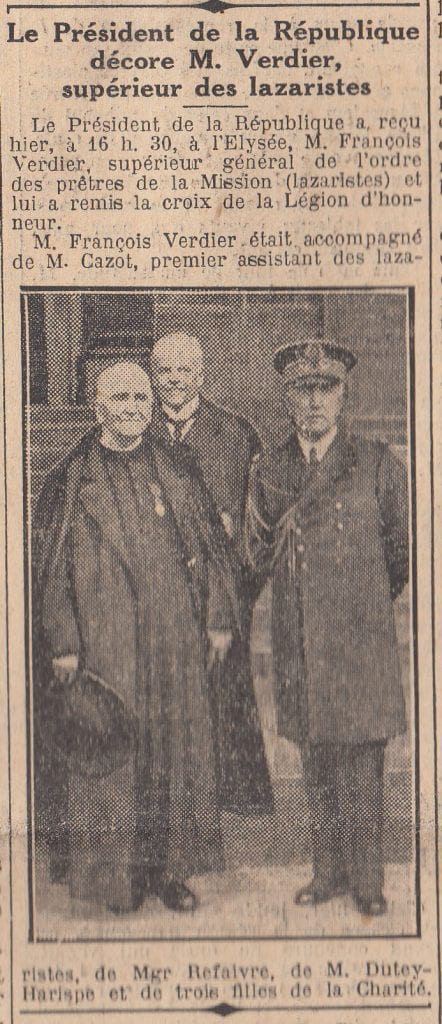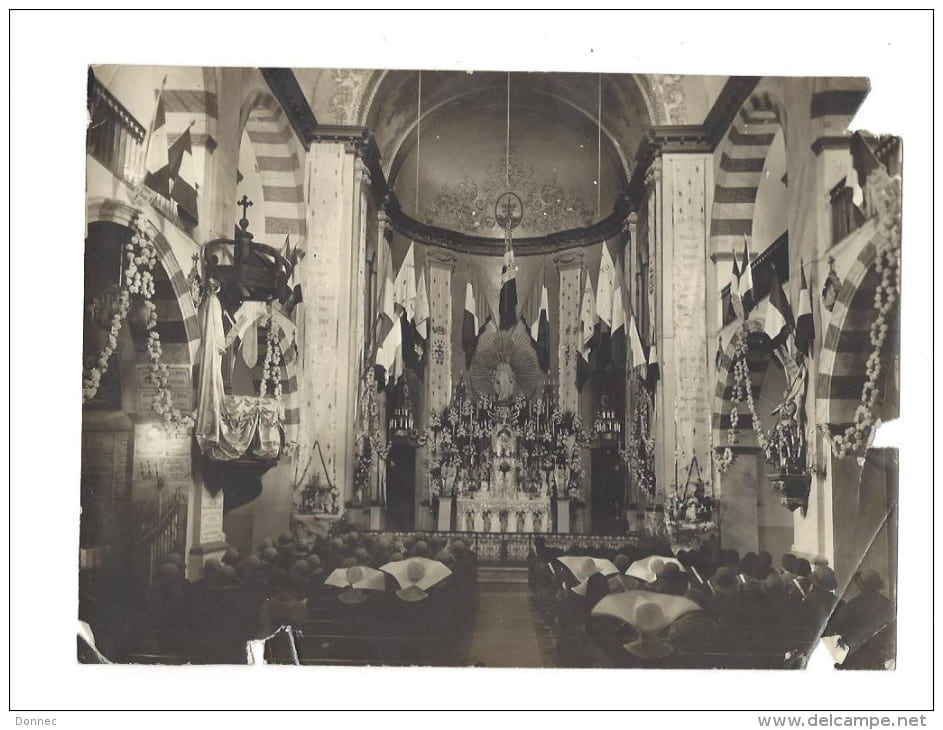The Vincentiana Collection at the Archives and Special Collections Department of DePaul University’s John T. Richardson Library recently purchased this late 19th century bronze bust of Saint Vincent de Paul. The bronze casting is of the highest quality, and the bust is mounted on a red marble base. The artist or foundry are unknown. The bust is 10.6 inches in height, 4.7 inches in width and 3.7 inches in depth.
What Am I Supposed To Do Now?
The whole world – at least our world in the United States – is trying to grasp the horrors that unfolded when a man held out a gun and shot former colleagues on live television. Everything worsened when news broke that the shooter captured his heinous acts on camera and posted them on social media. Several of us in the office today were sharing our feelings, wondering about a world that has gone so awry and asking a lot of questions. We learned that we were all horrified and bewildered together and we probably aren’t alone, so we thought we share some of our ponderings with you. Please share comments with us.
“Did you see the video?”
“Yes. I heard about it and went to my office. I googled it. I saw it, it was terrible – and then I went to another video… I watched the horror unfold. And then I sat there for twenty minutes wondering what I was supposed to do with it. I saw this! Now I am part of it!”
“I went on-line and tried to watch it. I am so thankful the screen was black…but I kept looking for the video and every screen went black. And then I sat there and wondered what had driven me to even want to see this. And yet I was absolutely glued to the screen, listening to the news briefs, clinging to the drama and sucked in.”
“And that’s what he wanted us all to do. We did the very thing he was hoping for! I did exactly what he wanted me to do!”
“I’m upset on multiple levels. I’m upset that it happened. I’m mad at our country because of the need to minimize the impact of gun violence.”
“I’m horrified that these violent killings are being used by some hate groups as a call to arms and to try and discredit the Black Lives Matter movement, which wasn’t involved.”
“We’re all part of this. News stations got some of the highest ratings because of this horror. Companies and networks make money on this through advertising.”
“I feel sick to my stomach just thinking about it. I’m mad at myself, I’m sad at where we are in our society. I’m scared about my kids…all kids. What messages are they getting?”
“Yeah, what about those kids who actually saw the video? Now those kids can’t tell the difference between reality and play.”
“We witness this killing stuff all the time because of video games. What I do when I’m playing games looks just like the video that this guy posted. We’re in the middle of it all the time.”
“But that’s the thing that makes us numb. And those of us who saw the video or attempted to see it are in the middle. It’s real because of what we saw or tried to see or refused to stop watching as more and more news unfolded.”
“And it should be real, right? These things are happening and need to be acknowledged instead of ignored! And yet – this feels so gross and voyeuristic. Is that what it takes to get attention? I hope not. …Will good ultimately come out of it?”
“Because of social media we’re always welcomed into different worlds.”
“What do we do with this? How are we supposed to feel? What are we supposed to do?”
“It seems like all we can do is throw our hands up in the air and ask, ‘What do we do?’”
“I wish we had the answers. This is a scary world.”
“Maybe we can just ask the questions and keep talking about it. We don’t have answers…how can we?”
“But we need to take action!”
This conversation unfolded with a sense of helplessness. We know we’re all in this together. We are having the conversations.
We thought of Vincent who has inspired us to ask what we must do. “What must be done?”
And we are comforted by his words: “What keeps [community] together is the unity of hearts.” We may not have answers right now and we know the world is heaped with horrors…but we’re feeling the pain, we’re moved by the atrocities…and together we might figure out what must be done to stop this kind of horror in our world.
We offer this with heavy hearts, with hopeful hearts, and we invite you into the conversation.
Emily Johnson, DePaul Junior; Matthew Charnay, DePaul Jewish Life Coordinator; Katie Brick, Office of Religious Diversity; Rev. Diane Dardón, DePaul Protestant Chaplain
Publication Announcement: “Balm of Hope: Charity Afire Impels Daughters of Charity Civil War Nurses”
Betty Ann McNeil, D.C., ed., Balm of Hope: Charity Afire Impels Daughters of Charity Civil War Nurses, Mary Denis Maher, C.S.A., Foreword; Janet Leigh Bucklew, Introduction (Chicago: DePaul University Vincentian Studies Institute, 2015), 558 pp., annotated, 50 historic images, 6 maps and tables, appendix, glossary, and index. Paperback. Available from DePaul University Vincentian Studies Institute Collection at the Seton Heritage Shop of the National Shrine of Saint Elizabeth Ann Seton, 339 South Seton Avenue, Emmitsburg, Maryland 21727 USA. Available: September 15, 2015 Cost: $30.00 plus shipping & handling
To order Balm of Hope: Charity Afire Impels Daughters of Charity Civil War Nurses, contact the Seton Heritage Shop: On-line: http://www.setonheritage.org/shop/ Email: giftshopmanager@setonheritage.org Telephone: 301-447-7122 Sr. McNeil’s discovery of 500 pages of handwritten memoirs by Daughters of Charity Civil War nurses led her into a multi-year project to transcribe, annotate, index, and publish Balm of Hope: Charity Afire Impels Daughters of Charity Civil War Nurses. This compendium includes: 1. Notes of the Sisters’ Services in Military Hospitals; 2. Civil War Recollections and Accounts; and 3. Correspondence.
The texts invite readers to listen to courageous women reminisce in their own words about nursing amid the ravages of war.
Welcome to Common Hour
Fr. Guillermo Campuzano, C.M. welcomes new DePaul students in the Discover and Explore Chicago Quarter classes. It is to be used for the “Welcome to Common Hour Introduction Lesson.”
Newsnote: Vincentiana Purchase of the Week 8/17/2015 St. Vincent’s original parish church: Pouy
This small rare sepia photograph was recently acquired by the Vincentiana Collection at DePaul University’s Archives and Special Collections. The photograph shows the original parish church at Pouy (near Dax) where St. Vincent was baptized and where he presumably also made his first communion. The town was renamed Saint Vincent de Paul in the 19th century to honor its most famous son. The photograph dates sometime before 1913 when the church had to be torn down because of severe storm damage. Other picture postcards survive but all show the church from the angle of the flood plain below.
Newsnote: Could this be a portrait of Louise de Marillac?
The above painting is in the collection of the Museum Calvet in Avignon France. It is described as a “Portrait d’une Religieuse.” It is attributed to the “Ecole Francaise XVIIe, Inv. 278). The upper right-hand corner has the notation of 1644 and the signature of Lenain. The Le Nain brothers: Antoine (c. 1599-1648), Louis (c. 1593-1648), and Mathieu (1607-1677) worked in Paris in the middle of the 17th century. Could this be a previously unknown portrait of Louise de Marillac? In 1644 Louise would have been 53 years old and often in ill-health (fairly old for a 17th century woman). The woman in the portrait is wearing widow’s garb which bears a striking similarity to that worn by Louise. The oldest portrait of Louise is found in her 1676 biography of Nicolas Gobillon. This portrait bears some resemblance to this portrait of a younger Louise. More research is of course needed, but the possibility is intriguing…….
Dignity and the Death Penalty
by Fadya Salem
The Journal for Social Justice, University Ministry, and the Center for Public Interest Law had the honor and privilege of hosting Sister Helen Prejean for a roundtable discussion with students, faculty, and alumni in April.
Sister Helen, Nobel Peace Prize Finalist and New York Times bestselling author of the academy award winning movie, Dead Man Walking, is an anti-death penalty advocate who has served as a spiritual advisor to death row inmates.
As a law student, I was eager to join the discussion with Sister Helen. After having studied wrongful convictions in an undergraduate course, I came to law school with the desire to advocate for those who have wrongfully fallen victim to the criminal justice system. I learned from Sister Helen the importance of not only fighting for the people we believe are innocent, but to advocate for the rights of those who have done something wrong, because they too should still be treated with dignity.
My religion, like some others, teaches that there are certain acts that are punishable by death. I sought to participate in this discussion in hopes to reconcile my religion’s views with my moral belief that the death penalty is wrong. I was moved by Sister Helen’s discussion on Boston Marathon bomber Dzhokhar Tsarnaev, whom she spoke on behalf of during his trial, and her insistence that, although his actions caused three people’s death, he still has human dignity.
Sister Helen began her anti-death penalty advocacy while living in the St. Thomas housing project in inner-city New Orleans. It was there that she became aware of the harrowing connection between poverty and oppression and prison. While in St. Thomas, she became pen pals with a Louisiana death row inmate.
The roundtable conversation began with Sister Helen describing her first experience as a spiritual advisor for a death-row inmate. She described it as a “secret ritual” that much of the rest of the world renounces. This experience became the subject of her first book, Dead Man Walking. The book was published in 1993, a time when 80% of Americans supported the death penalty.
Despite the large number of death penalty supporters, Sister Helen knew the story needed to be told. She finds that many people who support the death penalty do not know much about the process and what it entails. She works tirelessly to resist the death penalty and educate the public as a lecturer and writer.
When asked how she chooses inmates to work with, Sister Helen said it is a decision that she can’t explain. She has been a spiritual advisor to five death-row inmates, visiting with them from throughout their time in prison and to their execution. She also counsels the families of murder victims as the founder of “Survive,” a victim’s advocacy group in New Orleans.
A powerful point in the conversation came when Sister Helen pushed the group to think about how we treat a human with dignity. With the firm belief that “everyone is better than the worst thing they’ve ever done,” she reminded attendees that, despite their actions, people in jail are still human, which is the same value that St. Vincent advocated in his work.
I recall a discussion in my criminal law course about different methods of executions, when a fellow student asked, “If they killed someone, why do we care how we treat them?” For many people, the death penalty is such an abstract phenomenon that may be difficult to conceptualize. Sister Helen adamantly believes that if people knew what happens at executions, there would not be as many supporters.
Sister Helen described the important role lawyers play in anti-death penalty work: Lawyers are critical in framing the story told about inmates and furthering the idea that they are better than their crimes. For death-row inmates, lawyers and advocates are often times the only human dignity they have left. It is the passion for human dignity that keeps Sister Helen moving forward in her fight against the death penalty.
Fadya Salem just completed her first year of law school at DePaul. A Chicago native, she is an alum of the University of Illinois and hopes someday to practice law within the public interest arena.
An earlier version of this piece was published online by the Center for Public Interest Law at DePaul University in May.
Newsnote: Biography of Thomas A. Judge, C.M., to be published by Catholic University of America Press
Available: October 2017 Every Catholic An Apostle A Life of Thomas A. Judge, CM, 1868-1933 By William L Portier The Catholic University of America Press Born in Boston of immigrant parents, Thomas A. Judge, CM (1868-1933) preached up and down the east coast on the Vincentian mission band between 1903 and 1915. Disturbed by the “leakage” of the immigrant poor from the church, he enlisted and organized lay women he met on the missions to work for the “preservation of the faith,” his watchword. His work grew apace with, and in some ways anticipated, the growing body of papal teaching on the lay apostolate. When he became superior of the godforsaken Vincentian Alabama mission in 1915, he invited the lay apostles to come south to help. “This is the layman’s hour,” he wrote in 1919. By then, however, many of his lay apostles had evolved in the direction of vowed communal life. This pioneer of the lay apostle founded two religious communities, one of women and one of men. With the indispensable help of his co-founder, Mother Boniface Keasey, he spent the last decade of his life trying to gain canonical approval for these groups, organizing them, and helping them learn “to train the work-a-day man and woman into an apostle, to cause each to be alert to the interests of the Church, to be the Church.” The roaring twenties saw the work expanded beyond the Alabama missions as far as Puerto Rico, which Judge viewed as a gateway to Latin America. The Great Depression ended this expansive mood and time and put agonizing pressure on Judge, his disciples, and their work. In 1932, the year before Judge’s death, the apostolic delegate, upon being appraised of Judge’s financial straits, described his work as “the only organized movement of its kind in the Church today that so completely meets the wishes of the Holy Father with reference to the Lay Apostolate.” About the Author William L. Portier is in the Department of Religious Studies, University of Dayton and author of Divided Friends: Portraits of the Roman Catholic Modernist Crisis in the United States (CUA Press) Publisher The Catholic University of America Press
Newsnote: Vincentiana Purchase of the Week: 1929 centennial celebration, Damascus, Syria
The ongoing tragedy of the collapse of Syria reminds us of the long presence of the Lazaristes and Daughters of Charity in this country. The Vincentiana collection at DePaul University’s Archives and Special Collections has recently purchased this photo of the May 1929 celebration in Damascus of the 100th anniversary of the arrival of the French Lazaristes.








